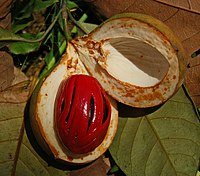
Photo from wikipedia
Abstract This study aims to evaluate whether machine learning techniques can be successfully applied to process the complex information contained within the molecular abundance distributions of plant wax n-alkane and… Click to show full abstract
Abstract This study aims to evaluate whether machine learning techniques can be successfully applied to process the complex information contained within the molecular abundance distributions of plant wax n-alkane and n-alkanoic acid homologous series. We trained five vegetation identification models using plant wax chain length distributions from modern plants in the Mojave Desert (hyperarid) and the San Bernardino Mountains (conifer forest) and previously published data for macrophytes from Blood Pond (USA) and Mt Kenya (Kenya). All vegetation identification models proved accurate (mean classification accuracy = 0.81) at classifying the modern plant wax chain length distributions into desert plants, conifer and macrophyte categories. We then applied the models to fossil waxes extracted from a 76 m lacustrine sediment core drilled in Searles Valley, CA with an approximate age range of 10 to 150 kyrs (SLAPP-SRLS17) to reconstruct the proportion of desert plants, conifer woodland and lake vegetation. We compared our machine learning models with a previously published linear mixing model and validated our modelled plant type distributions by comparing the results with the archaeol caldarchaeol ecometric (ACE), a proxy for lake salinity, measured in the same core. We found a moderate positive correlation (r = 0.40) between the modelled desert plant proportion and high lake salinity in our models as well as a negative correlation (r = –0.45) between modelled macrophyte plants and ACE, validating the ability of the machine learning techniques to detect both xeric and macrophyte plant communities. Our results suggest that machine learning of plant wax molecular abundance distributions has potential to reconstruct past plant communities, given information from two compound classes and highly differentiated vegetation types.
Journal Title: Organic Geochemistry
Year Published: 2021
Link to full text (if available)
Share on Social Media: Sign Up to like & get
recommendations!